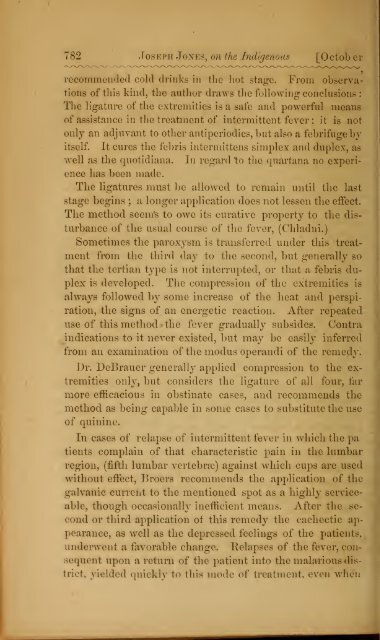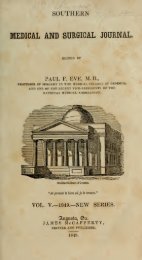Issue 10, pp. 753-832, October 1861, SMSJ
Issue 10, pp. 753-832, October 1861, SMSJ
Issue 10, pp. 753-832, October 1861, SMSJ
You also want an ePaper? Increase the reach of your titles
YUMPU automatically turns print PDFs into web optimized ePapers that Google loves.
782 Joseph Jones, on the Indigenous [Octob errecommended cold drinks in the hot stage. From observationsof this kind, the author draws the following conclusions :The ligature of the extremities is a safe and powerful meansof assistance in the treatment of intermittent fever ; it is notonly an adjuvant to other antiperiodics, but also a febrifuge byitself.It cures the febris intermittens simplex and duplex, aswell as the quotidiana. In regard to the quartana no experiencehas been made.The ligatures must be allowed to remain until the laststage begins ; a longer a<strong>pp</strong>lication does not lessen the effect.The method seems to owe its curative property to the disturbanceof the usual course of the fever, (Chladni.)Sometimes the paroxysm is transferred under this treatmentfrom the third day to the second, but generally sothat the tertian type is not interrupted, or that a febris duplexis developed. The compression of the extremities isalways followed by some increase of the heat and perspiration,the signs of an energetic reaction. After repeateduse of this method the fever gradually subsides. Contraindications to it never existed, but may be easily inferredfrom an examination of the modus operandi of the remedy.Dr. DeBrauer generally a<strong>pp</strong>lied compression to the extremitiesonly, but considers the ligature of all four, farmore efficacious in obstinate cases, and recommends themethod as being capable in some cases to substitute the useof quinine.In cases of relapse of intermittent fever in which the patients complain of that characteristic pain in the lumbarregion, (fifth lumbar vertebrae) against which cups are usedwithout effect, Brocrs recommends the a<strong>pp</strong>lication of thegalvanic current to the mentioned spot as a highly serviceable,though occasionally inefficient means. After the secondor third a<strong>pp</strong>lication of this remedy the cachectic a<strong>pp</strong>earance,as well as the depressed feelings of the patients,underwent a favorable change. Relapses of the fever, conlequentupon a return of the patient into the malarious district,yielded quickly to this niodo oi* treatment, even when








